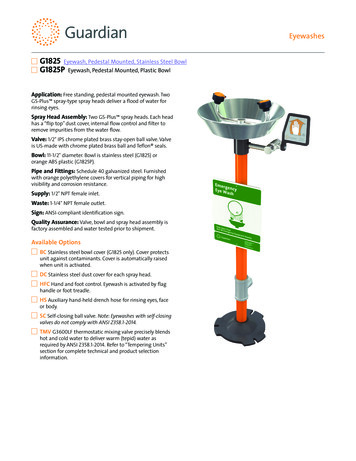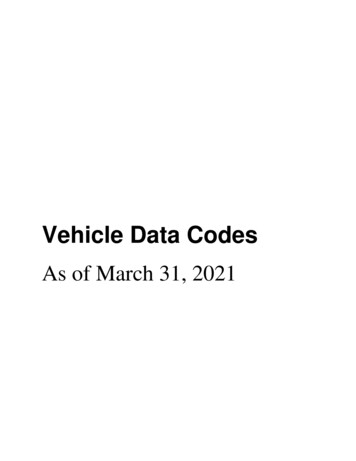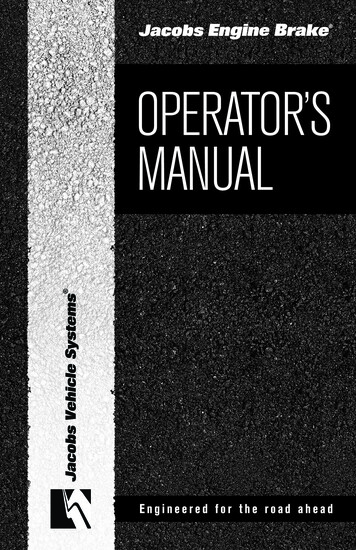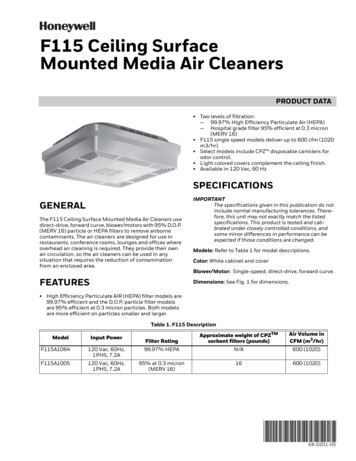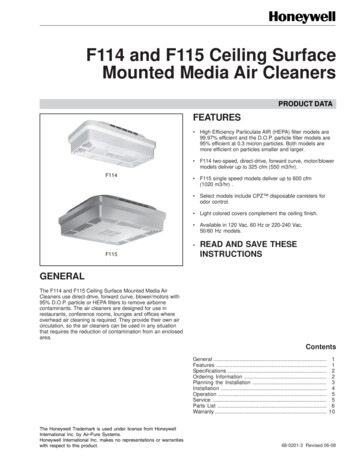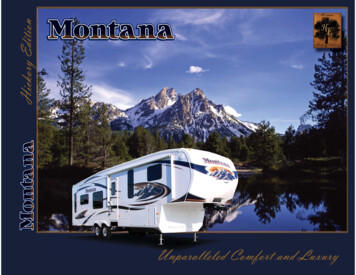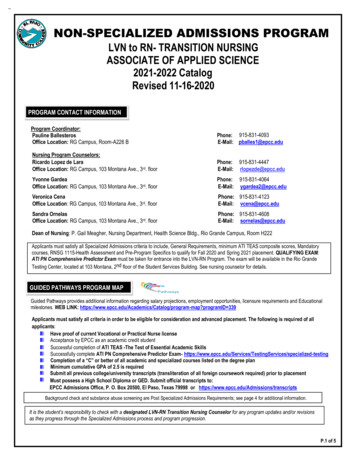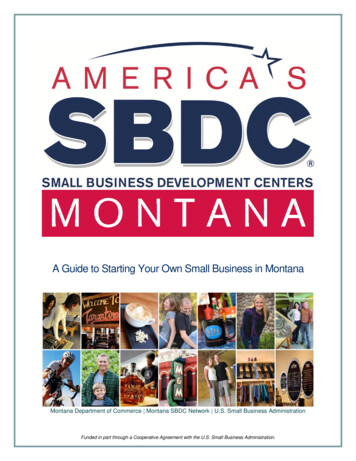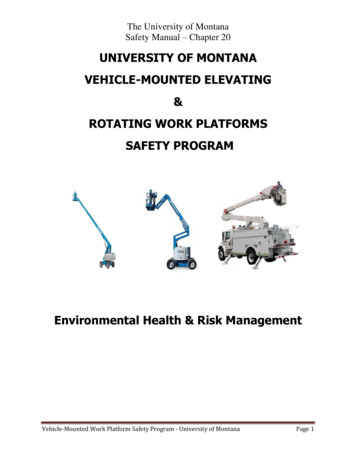
Transcription
The University of MontanaSafety Manual – Chapter 20UNIVERSITY OF MONTANAVEHICLE-MOUNTED ELEVATING&ROTATING WORK PLATFORMSSAFETY PROGRAMEnvironmental Health & Risk ManagementVehicle-Mounted Work Platform Safety Program - University of MontanaPage 1
The University of MontanaSafety Manual – Chapter 20Table of IntroductionPurposeScopeResponsibilitiesTraining ProgramLift InspectionsLift MarkingMaintenanceStandard Operating ProcedureFall ProtectionRecords RetentionAppendicesAppendix A: Lift Familiarization Training Form3333567889910Appendix B: Operator Manual Acknowledgement FormAppendix C:Pre-Use Inspection FormAppendix D: Work Zone Inspection FormVehicle-Mounted Work Platform Safety Program - University of MontanaPage 2
The University of MontanaSafety Manual – Chapter 20I.IntroductionVehicle-mounted elevating and rotating work platforms (mobile aerial lifts) arepresent on the University of Montana Campus which are used by University staff andcontractors. The University recognizes that there are potential hazards associatedwith the use of these lifts. The following safety program is based on OSHA 1910.67(Vehicle-Mounted Elevating & Rotating Work Platforms) and is designed to ensurethat these aerial lifts are operated in a consistent and safe manner.II.PurposeThe purpose of the vehicle-mounted elevating and rotating work platform safetyprogram is to provide University employees and contractors guidance in the safeand proper use of aerial lifts. The program will cover responsibilities, training,inspection, maintenance, standard operating procedures, fall protection andrecordkeeping.III.ScopeThis program applies to all University owned or rented aerial work platforms that arevehicle mounted and have telescoping or articulating booms used to positionpersonnel. This program does not cover scissor lifts. Please refer to the U of MScissor Lift Safety Program for details regarding proper use of this type of lift.IV.ResponsibilitiesA) Department Directors: Ensure that responsibilities of this program are assigned to individualswithin their department Actively support the implementation and follow-through of this programwithin their department Ensure that adequate funding is available to support this programB) Environmental Health & Risk Management (EHRM): Develop a vehicle-mounted elevating & rotating work platform safetyprogram and revise it when necessary Ensure that initial training is provided to all aerial lift operators throughthe cooperation from applicable departments. Conduct periodic audits of operator training records.Vehicle-Mounted Work Platform Safety Program - University of MontanaPage 3
The University of MontanaSafety Manual – Chapter 20 Provide technical support to departments and employees whenquestions or concerns arise with regard to aerial platform lift safety.Conduct periodic audits to ensure that the inspections are beingcompleted appropriately.C) Department Managers: Contact EHRM prior to the purchase of an aerial lift so that inventoryinformation can be updated. If buying used equipment, ensure that an inspection is done on the liftprior to placing the unit in service. Ensure that the operating and maintenance manuals have been received. If renting a lift, ensure that the U of M lease agreement with HoldHarmless / Indemnification verbiage is present. When renting a lift initially, departments shall require that the rentalagency provide specific lift familiarization training for the particular liftthat they are renting prior to lift use. The form in Appendix A shall besigned by each trainee and the trainer for proper documentation. Ensure that all operators of the lift review the operator’s manual and signthe acknowledgement form prior to the initial use of the lift (Appendix B). The Department must ensure that operators receive specific lift trainingfrom competent trainers, the manufacturer or vendor, or an approvedcontracted trainer before operating an aerial lift. Departments mustdocument this training. When safety-related concerns have been discovered through inspections,the lift shall be locked out of service until the item(s) has been repaired. When lifts are used outdoors, the Department must ensure that weatherconditions are continuously monitored throughout the use of the lift andthat an anemometer (wind velocity meter) is attached to the lift’spersonnel platform or a hand held anemometer is used. Aerial platformlifts may not be used when wind speeds reach 28 mph or more; whenthere is a weather warning in effect for winds in excess of 28 mph; whenlightning is observed; or when thunderstorm warnings are in effect. The Department must provide and encourage flexibility for the users ofthe lifts by giving them discretion of lowering the lift at any time if theyhave concerns for their safety.D) Operators Review the operator’s manual prior to the initial lift use. Documentationof this shall be completed using the “Operating ManualAcknowledgement Form” in Appendix B of this document. Know and understand the following about the lift that they operate, priorto the initial operation of the lift:Vehicle-Mounted Work Platform Safety Program - University of MontanaPage 4
The University of MontanaSafety Manual – Chapter 20 V.1. Safe operation2. Hazardous conditions which jeopardize safety3. All control features of the lift4. All placard warnings5. All safety devices on the lift6. Fall arrest system components and anchor locations7. Where to locate the user manualPerform a Pre-operation inspection of the aerial lift prior to each day’s(or shift’s) use of the lift. Documentation of the pre-operationinspections shall be performed by completing the Pre-OperationInspection Form (Appendix C). Aerial lifts that are not in properoperating condition shall be immediately removed from service andreported to the appropriate departmental manager.Prior to setting up the lift at each new location, the operator shallconduct a work zone inspection to identify potential workplace hazards.Weather conditions must be continuously monitored through a real-timeweather source and an anemometer must be present on all vertical aerialplatform lifts through the duration of the use of the lift outdoors. Forvehicle-mounted aerial platform lifts, see the operating manual for windspeed guidelines.Operators must notify their supervisor if the lift does not pass inspectionor if any unsafe condition is identified.If at any time, the operators are concerned for their safety, they may, attheir discretion, lower the lift and stop their work activities.Training ProgramOnly trained and authorized operators may operate an aerial platform lift at theUniversity of Montana. To become authorized, staff must successfully complete aninitial training program. Operators must demonstrate proficiency in the actualoperation of all functions of the equipment Factors affecting stabilityWhen and how to perform inspectionsSafety rules and regulationsOperator warnings, load capacity and instructionsThe use of fall arrest systemsThe use of wind monitoring equipment, including the lift anemometer foroutside lift use, and reinforcement of the operator’s authority to come downfrom the lift if they have safety concerns.Vehicle-Mounted Work Platform Safety Program - University of MontanaPage 5
The University of MontanaSafety Manual – Chapter 20The Familiarization training is specific to the make and model of the lift that they willbe operating. The trainer may be an experienced and competent operator, arepresentative of the lift manufacturer or distributor, or a contracted trainingprovider. Both the trainer and trainee must sign the Specific Lift FamiliarizationTraining Form.Re-training will be required of any operator that has been involved in an aerialplatform lift incident; a different type of aerial lift is used; or when the operator hasbeen observed performing unsafe practices involving the lift.VI.Lift InspectionsBecause each make and model is different, the inspection criteria may differ. Pleaserefer to the operator’s manual for the specific criteria required for each particularlift that needs to be inspected. Additional inspections must be conducted after anyoccurrence that could affect the structural integrity of the equipment.Pre-Use InspectionsPrior to using an aerial lift, a pre-use inspection shall be conducted to verify that theequipment and all its components are in safe operating condition. Follow themanufacturer’s recommendations for the specific lift but it should include a checkof:Vehicle Components Proper fluid levels (oil, hydraulic, fuel and coolant) Leaks of fluids Wheels and tires Battery and charger Lower-level controls Horn, gauges, lights and backup alarms Steering and brakesLift Components Operating and emergency controls Personal protective devices Hydraulic, air, pneumatic, fuel and electrical systems Fiberglass and other insulating components Missing or unreadable placards, warnings, or operational, instructionaland control markings Mechanical fasteners and locking pins Cable and wiring harnessesVehicle-Mounted Work Platform Safety Program - University of MontanaPage 6
The University of MontanaSafety Manual – Chapter 20 Outriggers and stabilizersLoose or missing partsGuardrail systemWork Zone InspectionsBefore an aerial platform lift is used, the operator must visually check the work zonearea where the lift is to be used, identifying potential hazards such as, but notlimited to: Drop-offs, holes, unstable surfaces Slopes, ditches or bumps Debris and floor obstructions Overhead obstructions and power lines Hazardous locations and atmospheres Inadequate surface and support to withstand all load forces imposed bythe lift Wind and weather conditions Presence of others in close proximity to the workDepending on the nature of the workplace and the type of work being performed,additional items may be added to this list of criteria.Annual Inspection/CertificationAn annual inspection must be performed on all aerial platform lifts within thirteen(13) months from the date of the prior annual inspection. The inspection shall beperformed by a qualified mechanic who is authorized to perform maintenanceduties on the lift. An approved vendor shall be contracted through the U of MVehicle Garage to inspect and certify the lift.VII.Lift MarkingIn addition to any other markings or decals that are placed on the lift by themanufacturer, the following information shall be displayed on all aerial platform liftsin a clearly visible, accessible area and in a durable manner: The make, model, serial number, and manufacturer’s name and address The rated workload, including rated number of occupants The maximum platform heightVIII.MaintenanceVehicle-Mounted Work Platform Safety Program - University of MontanaPage 7
The University of MontanaSafety Manual – Chapter 20All maintenance that is performed on aerial lifts shall be performed by trained andexperienced professionals. All equipment should be serviced in accordance with themanufacturer’s recommendations. Aerial Lift service occurs every 6 months throughthe University Vehicle Garage. Prior to making any modifications to the lift, theUniversity must obtain written permission from the manufacturer. The insulatedportion of an aerial lift shall not be altered in any manner that might reduce itsinsulating value.IX.Standard Operating ProcedureTo ensure safe practices, the following standard operating procedure shall be usedwhen an authorized employee operates an aerial platform lift: Obtain authorization to use or operate the lift from your immediatesupervisor. Before moving an aerial lift for travel, the boom(s) shall be inspected to seethat it is properly cradled and outriggers are in stowed postion. Do not work on aerial lifts covered with snow or ice or other slipperymaterial except as necessary for removal of such material. Perform a pre-start inspection on the lift. (Lift controls must be tested eachday prior to use to determine that the controls are in safe working condition) Perform a work zone inspection in the area that the lift will be used. The brakes must be set and outriggers, when used, must be positioned onpads or a solid surface. Wheel chocks must be used before using an aerial lifton an incline. Set up work zone warnings, such as cones and signs, when necessary to warnothers. Boom and basket load limits specified by the manufacturer must not beexceeded. Do not carry objects larger than the platform A body harness must be worn and a lanyard attached to the boom or basketwhen working from an aerial lift. (Not for scissor lifts) Tying off to an adjacent pole, structure or equipment while working from anaerial lift is prohibited. Employees shall always stand firmly on the floor of the basket, and must notsit or climb on the edge of the basket or use planks, ladders or other devicesfor a work position. Do not operate lower level controls unless permission is obtained from theworker(s) in the lift (except in emergencies) Do not exceed vertical or horizontal reach limitsVehicle-Mounted Work Platform Safety Program - University of MontanaPage 8
The University of MontanaSafety Manual – Chapter 20 X.Fall Protection XI.Ensure that wind conditions and horizontal (side) load forces are withinacceptable limits per the operator’s manual and this policy.Do not place or attach fixed or overhanging loads to any part of the machineor attaching fixed or overhanging loads to this machine or push or pulltoward any object outside the platformTreat all overhead power lines and communication cables as energized, andstay at least ten feet away.An aerial lift truck may not be moved when the boom is elevated in aworking position with personnel in the basket, except for equipment which isspecifically designed for this type of operation.Ensure that access gates or openings are closedStand firmly on the floor of the bucket or lift platformDo not climb on or lean over the guardrails or handrailsDo not use planks, ladders or other devices to increase working heightUse a body harness with a lanyard attached to the boom or bucket for aeriallifts only ( Not for scissor lifts)Do not tie off to adjacent structures or poles while in the bucketOperators shall remain tied-off until the work is finished and the basket hasbeen safely lowered to the groundRecords RetentionMaintenance, inspection and training records shall be maintained for equipment andits operators. The following records must be maintained for three years by eachdepartment who owns an aerial platform lift: Pre-start inspection documents. Work zone inspection documents. All training records. Annual inspection documentation, all maintenance performed, and alloperators’ manual acknowledgement forms.Vehicle-Mounted Work Platform Safety Program - University of MontanaPage 9
The University of MontanaSafety Manual – Chapter 20Appendix AUniversity of Montana Aerial Platform & Scissor LiftSpecific Lift Familiarization Training FormThis form documents the OSHA-required aerial platform and scissor lift training for University personnel.Each operator must be trained on each aerial platform or scissor lift that he/she operates. The SpecificLift Familiarization Training shall consist of a review of the following items:a). All safety placards and warningsb). All switches, drive mechanisms, adjustments, and controls (both lower andupper).c). The functional operation of the liftd). The use of outriggers or stabilizing equipmente). All gauges, horns, and lightsf). Proper fueling and/or battery charging proceduresg). Inspections and the inspection processAerial or Scissor Lift:Lift ManufacturerModelSerial #I certify that I have met with the trainee identified below and have reviewed the operations ofthe specific lift identified above and made myself available to answer any questions he/she may havehad with regards to the operation of this lift.Print Trainer’s NameSignature of TrainerDateI certify that I have met with the trainer identified above and that he/she has reviewed with me theoperations of the specific aerial platform or scissor lift identified above. I was given an opportunity toask questions which, if any, were answered to my satisfaction and that I now have the necessaryunderstanding of the operations of this lift. I am also certifying that I have received general training onthe safe operation of aerial platform or scissor lifts through the Environmental Health and RiskManagement Department or the specific University Department that owns or rents the lift. I havereviewed the operator’s manual for this lift and have been given the opportunity to ask questions that Imay have had.Print the Trainee’s NameSignature of TraineeDateTrainer’s Department or Company Name:Vehicle-Mounted Work Platform Safety Program - University of MontanaPage 10
The University of MontanaSafety Manual – Chapter 20Appendix BOperating Manual Acknowledgement FormBy signing this document, I am certifying that I have received a copy of the operations manual for theaerial platform lift shown below. Upon training and authorization by my department, I am expected tooperate this lift in a safe manner. I understand that it is my responsibility to review and understand thesafe operation of this aerial platform or scissor lift based on the training I receive and themanufacturer’s recommendations. I understand that if, at any time, I have any questions regarding theinformation found in the user’s manual, I can contact Environmental Health & Risk Management, mysupervisor, or the manufacturer to obtain answers.Aerial Lift Make:Aerial Lift Model:Name (print):Department:Operator’s signature:Date:Vehicle-Mounted Work Platform Safety Program - University of MontanaPage 11
The University of MontanaSafety Manual – Chapter 20Appendix CAerial Platform & Scissor Lift Pre-Start Inspection FormThe pre-start inspection shall be performed prior to each day’s or shift’s use of the aerial platform lift byan authorized and trained operator of the lift. Documentation of the inspection shall be maintained byeach department, with a copy of the most recent inspection document stored on the lift.Check off the items that have been inspected or mark the N/A box if the item does not apply to the liftbeing inspected. Place any comments I the space provided below. If there are any of these items thatare not satisfactory, place the lift out of service until the item is corrected.Department lift belongs to:Make of lift:Model of lift:Inspector’s Name:Item InspectedSerial #:Date of inspection:OKNot OKN/AOperating controlsEmergency controlsSafety devicesPersonal protective devicesPneumatic system (leaks)Hydraulic system (leaks)Fuel System (leaks)CablesWiring harnessLoose/missing partsTires and wheelsPlacards and warningsOperational manualOutriggers/StabilizersGuardrail system & locking gateAnemometer present (outdoor usage)Other itemsComments:Inspector’s Signature:Vehicle-Mounted Work Platform Safety Program - University of MontanaDate:Page 12
The University of MontanaSafety Manual – Chapter 20Appendix CAerial Platform & Scissor Lift Work Zone Inspection FormThe work zone inspection shall be performed prior to using the aerial platform or scissor lift. Oneinspection may be performed for multiple tasks taking place in a single room/space per day. The workzone inspection must be performed by the individual who will be using the lift. Documentation of theinspection shall be maintained by each department and provided to EHRM on a monthly basis.Check off the items that have been inspected and abate any safety issues that were identified prior tousing the lift. Place any comments in the space provided below.Department lift belongs to:Location; bldg. or room number where lift will be used:Inspector’s Name:Date of Inspection:Item ObservedCompletedN/ADrop-offs or holesSlopesBumps or floor obstructionsDebrisOverhead obstructionsHazardous locations and atmospheresInadequate surface and supportWind and weather conditions- Wind readings & forecasts indicate 28 mph- No lightning visible or forecasted- No other severe weather forecastedDo not operate lift when winds reach 28 mph or more, when a wind warning is in place of 28 mphwinds or greater, or when lightning is observed or thunderstorms are in effect.Presence of unauthorized peopleOther possible unsafe conditionsInspector’s signature:Date:Vehicle-Mounted Work Platform Safety Program - University of MontanaPage 13
Safety Manual – Chapter 20 Vehicle-Mounted Work Platform Safety Program - University of Montana Page 6 The Familiarization training is specific to the make and model of the lift that they will be operating. The trainer may be an experienced and competent operator, a representative of the lift manufacturer
